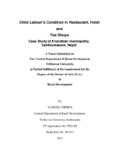Please use this identifier to cite or link to this item:
https://elibrary.tucl.edu.np/handle/123456789/2225| Title: | Child Labour’s Condition in Restaurant, Hotel and Tea Shops Case Study of Khandbari municipality, Sankhuwasava, Nepal |
| Authors: | Sherpa, Yangdu |
| Keywords: | child laborers;socio-economics |
| Issue Date: | 2073 |
| Publisher: | Central Department of Rural Development |
| Abstract: | The research reflects the Child Labour’s Condition in Restaurant, Hotel and Tea Shops a Case Study of Khandbari municipality, Sankhuwasava District, Nepal’. In Nepal Children are facing various problems due to the backwardness. 'Poverty' and 'illiteracy' are the main causes of 'child labor' in Nepal. Generally, Child laborers are those who are below 14 years of age, engaged in different physical activities without desired level of facilities, working long hours, getting low wages and losing opportunity of their physical and mental development. This study is basically in descriptive and analytical form. For the completion of this study both primary and secondary data have been used. The primary data were collected from scheduled interview, observation and key informant interview from 30 respondents selected from simple random sampling under the probability sampling. The secondary data were collected from different books, reports, articles, study reports of individuals and from web sites of different offices. The collected data were edited, coded, and tabulated and these were analyzed by using computer application soft-wares. A child who is first setting foot is an urban area is most likely to gain easy employment in a roadside restaurants, hotel and tea shops. Cheap labor demands are high and skills are not required. At times the children get involved with the help of parents, relatives or friends. These children do not have any option other than working whatever job they can lay their hands on. Child labor is a reflection of the socio-economic reality of the country.. Poverty is obviously one of the push factors of child exploitation but there are many other pull factors, which contribute for the continuity of poverty, hunger and starvation. Because of the unaware society people give birth to many children then they can take care or the parent break which lead the children to drop out to live on their own, which ultimately push children to work on their early age for their food. The poverty is the leading cause of child labor in general. However, other factors like inequality to resources, large family size, illiteracy, lack of schooling facilities, dysfunctional families also contribute children to enter into labors market at their early age. Also it was found that, children have to support their family due to the poor economic condition. As a result, they have to leave school or they cannot go to school. At last, it is concluded that the child workers in hotels and restaurants are one of the worst forms of child labor. It is not only the poverty but also parent illiteracy, lack of schooling facilities, lack of employment opportunities and weak legal enforcement are also the contributing factors for children to be engaged on such labor. The necessity of today is, to protect working children from exploitation abuses, improper influence, illiteracy, ignorance and hazardous condition to develop their physical mental, social and moral development. |
| URI: | http://elibrary.tucl.edu.np/handle/123456789/2225 |
| Appears in Collections: | Rural Development |
Files in This Item:
| File | Description | Size | Format | |
|---|---|---|---|---|
| thesis.pdf | 383.46 kB | Adobe PDF |  View/Open |
Items in DSpace are protected by copyright, with all rights reserved, unless otherwise indicated.
